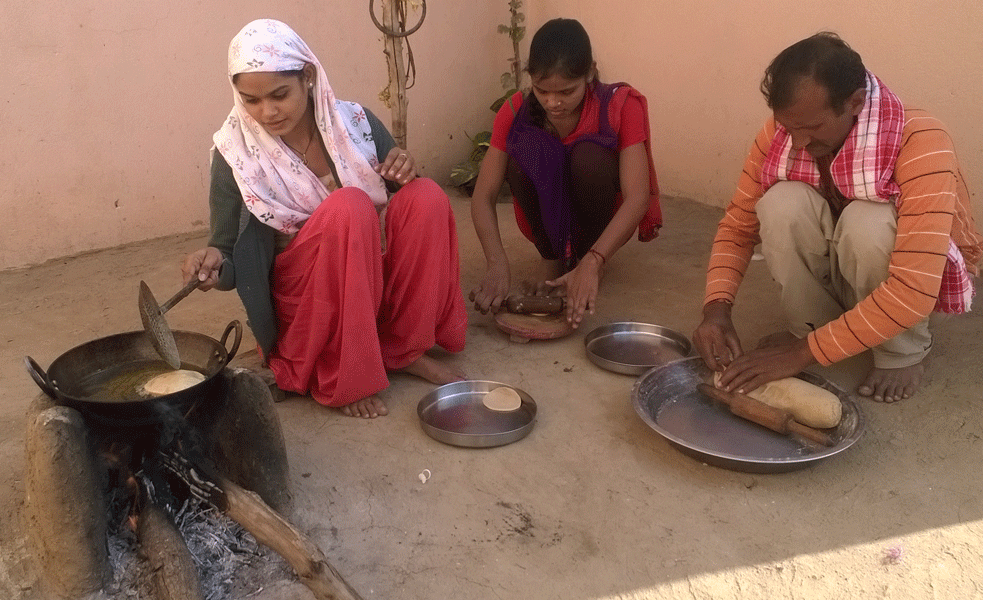The children in my village are now actively participating in sports and they all love running. I have noticed this change ever since they started eating the special ‘rotis’,” says Vijay Joshi, physical training instructor at a government school in Sheshpur village.

“I don’t get tired very soon these days and even my husband’s knee pain has reduced considerably,” shares Sumitra (30), anganwadi worker of Singhavat village.
“Till just a few months back, there was not a day when I didn’t feel listless or feverish. Carrying out my duties as a government school teacher and helping out in serving the mid-day meal, wasn’t easy. Thankfully, I feel much better and stronger,” says Varsha Sevak (26), government school teacher in Banora village.
There is a quiet health revolution underway across several villages in the tribal-dominated Salumbar and Sarada blocks of Udaipur district in Rajasthan, where widespread malnutrition, especially among women and children, has had devastating effects on their physical well-being. Since September 2012, households dotting the arid countryside have been motivated to consume wheat flour fortified with micronutrients such as iron, folic acid and vitamin B12, as part of a novel initiative introduced in the region by Global Alliance for Improved Nutrition (GAIN) and Institute of Health Management Research (IHMR), Jaipur, and implemented by the Bhoruka Charitable Trust (BCT).
Nutritional deficiencies are rampant in Rajasthan. The National Family Health Survey-3 has noted high levels of anaemia, stunting and wasting. That’s because a typical home-cooked meal here is imbalanced: it includes high quantities of cereal — that are cheap and provide energy — and very little pulses and fruits and vegetables, which are rich sources of vitamins and minerals, critical for proper growth and building immunity.
Considering that the diet of these people is not diversified, provision of staple foods such as wheat, oil and milk that have been fortified with vitamins and minerals is considered one of the best ways of improving the health indicators. Not only is food fortification easy and cost-effective, it is also an inexpensive way to provide good nutrition and sufficient vitamins and minerals for health improvement in a short time,” says Deepti Gulati, Senior Associate, GAIN.
In Udaipur, Salumbar and Sarada blocks were identified for action after a baseline survey showed locals suffering from high levels of micronutrient deficiencies. Rahul Sharma, Director, Food Fortification Project, IHMR, said wheat flour being the major staple cereal in this region, was chosen as the vehicle for fortification.
The next step was ensuring the use of fortified flour (‘atta’). For this, reaching out to the friendly neighbourhood chakki wallahs (millers), where households get their wheat grain milled, became imperative. They had to be convinced that by adding the micronutrient-rich premix to the flour, they could become “agents of change” to improve the community’s health.
About 200 chakki-owners were identified and actively engaged in this initiative and trained on how, when and how much to add the premix.
Shivendra Kumar Jha, BCT Project Manager, says, “Initially, the millers had several questions and apprehensions like ‘why should I do it?’; ‘do I get anything for doing it?’; ‘will the quality of flour get affected and impact my business?’ So we had to tell them that it was their social duty to contribute in this fight against malnutrition.”
Other challenges emerged soon enough. Some people complained that the fortified dough made rotis dry. An investigation showed that some of the millers were adding a higher quantity of the premix, thinking if it was good for health then why stop with just one spoon! They were educated that it was important to stick to the right dose and eventually both the millers and consumers were happy!
Now an information campaign is on to publicise the advantages of consuming fortified wheat flour, and this includes community meetings, campaigns and street plays, says Jha.
But, as Khajhrulal Jain, one of the three millers in Jhallara village of Salumbar block, points out, only 60–65 per cent of his clients are convinced, and they tend to be the educated ones.
Anganwadi workers and Accredited Social Health Activists , who give nutritional advice to village women, are pitching in to increase the usage of fortified flour. Anita, from Dhoodhar, a small village in Salumbar, is one of them. As a grassroots government health worker she counsels families on the importance of eating nutritious meals. “I tell them how it reduces anaemia among women and gives strength to their children. And the best part: there is no extra cost involved!”
Jha says that in the last eight-nine months, fortified flour is being used by about 6,600 homes in Salumbar and Sarada.





